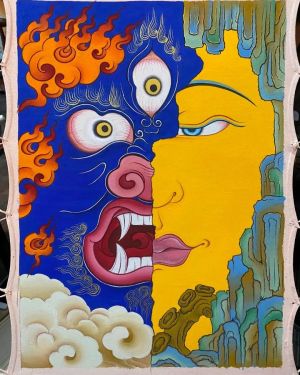What Does Tantra Mean?
Tantra refers to both the philosophy and set of spiritual practices that emerged in India around the 6th Century, focused on the direction and manipulation of universal energy as a means of liberation.
Though it is most commonly understood to be a co-development of esoteric Hindu and Buddhism traditions, Tantra has also influenced a variety of Eastern religions such as Daoism, Shinto, Jainism and Tibetan Bon.
The term is derived from the Sanskrit root tan meaning "to weave" or ‘"o compose," and refers specifically to a type of instructional text, often presented as a dialogue between a god and a goddess.
These texts outline rituals and practices which can be used to invoke the energy of Tantric deities, including a Tantric interpretation of yoga known as Tantra yoga. Generally passed directly from guru to student, Tantric teachings are believed to grant spiritual transformation and even supernatural powers.
Yogapedia Explains Tantra
Tantra is a life-embracing philosophy, loosely defined as a path to liberation. It consists of a wide variety of practices, many of which transgressed the social and religious boundaries of the time in which Tantra emerged.
Tantra teaches that everything is sacred, including the traditionally profane or impure—for example, sexual rites and engagement with the taboo, such as intoxicants. As such, Tantra has gained an erroneous reputation for advocating uninhibited sex, when really it simply teaches a direct engagement with sexual energy,
The Tantric worldview sees all material reality as animated by divine feminine energy known as Shakti. Tantric goddess worship challenges the traditional roles of women, representing femininity as erotic and powerful.
Tantra uniquely intertwines the destructive and the maternal in its depiction of goddesses, most prominently in the cases of Durga and Kali, both of whom are simultaneously defined as warrior goddesses and mother figures.
According to Tantra, an individual's source of Shakti lies dormant in the base of their spine as kundalini. Often likened to a serpent, kundalini is connected to a network of energy channels known as nadis and energy centers called chakras.
Awakening kundalini energy is the primary goal of most Tantric practices, including pranayama, mudras, mantras, meditation and other yogic purification practices. These rituals aim to expand consciousness and liberate the practitioner from the physical level of existence.
Tantra is distinct from certain other spiritual traditions in that it focuses on liberation via the physical body rather than through transcendence of it. Through experimentation, Tantric practices are designed to direct universal energies into the practitioner as a means of breaking free from ignorance and suffering, thereby enabling union with the Divine.
During These Times of Stress and Uncertain
Your Doshas May Be Unbalanced
To help you bring attention to your doshas and to identify what your predominant dosha is, we created the following quiz.
Try not to stress over every question, but simply answer based off your intuition. After all, you know yourself better than anyone else.
Knowing your current vikriti or state of health can help you understand how your health works and how Ayurveda can help you find balance.
Answer the following questions based upon how you are feeling at the moment (or at least within the recent few weeks). In the case where more than one answer is applicable, select the one that is the most true for you.
